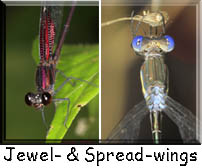 A First Guide to the Damselflies of Jalisco, Mexico
A First Guide to the Damselflies of Jalisco, Mexico
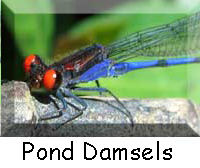
This includes all species as found on Dennis R. Paulson and Enrique González Soriano's list of Mexican Odonata species
(photos by Dave &/or Kathy Biggs unless marked otherwise) *= go to glossary at bottom of page.
Click on links (blue text) to go to more information & other images of the species.
=!=
This webpage is also available in Spanish. Click here!
Para ver esta página web en espańol, haga clic aquí por favor
Download A First Guide to the Dragonflies of Jalisco
as a FREE printable PDF
=!=
For help with identifications &/or to make a photo contribution, contact Kathy Biggs or upload to iNaturalist
Click here to view an  Excel Chart of the species in Jalisco
by municipality (similar to a county).
Excel Chart of the species in Jalisco
by municipality (similar to a county).
If you find a species in a new municipality, please submit it to iNaturalist/Naturalista.mx or Kathy Biggs.
| Common Name (Scientific Name)
photo & description maps Jalisco maps are courtesy of iNaturalist and are a work in progress, not current | |
DAMSELFLIES (ZYGOPTERA) Damselflies have widely separated eyes and long thin bodies. Most hold their wings closed above or alongside the abdomen. 5 of Mexico's 8 families of damselflies have been recorded in Jalisco (several families have recently been merged into Pond/Narrow-winged Damsels) Click here to see the parts of a damselfly body 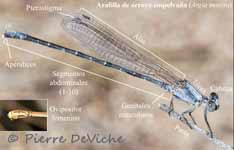
| |
| Shortcuts
Broad-winged Damselflies - all have red at the base of their wings and long legs Pond Damsel Damselflies - very common, variable and colorful Spreadwing Damselflies - perch with their wings spread delta-like to their sides Shadowdamsel Damselflies - secretive and only out dawn and dusk Bannerwing Damselflies - bulky bodies (for a damselfly) | |
Jewelwings (Calopterygidae) Only one genus in Mexico. All the males and some of the females in this genus have red in the basal area of their wings; some have additional coloration at the wing-tip Males may lead females to underwater plants and she may completely submerge for a long period of time, holding air between her wings, while he stands guard above (she may need assistance to break the water's surface tension when she is finished ovipositing). | |
American Rubyspot (Hetaerina americana) 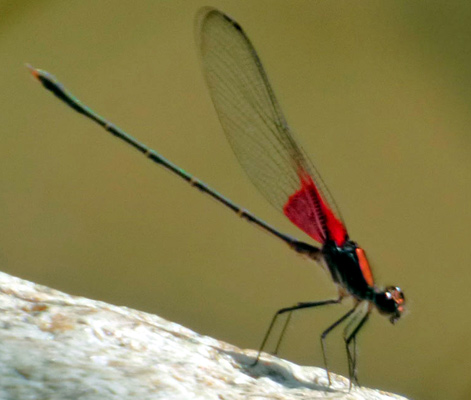

photos: male & female size: medium/large, length 36 - 51 mm male: 1/3 to 1/2 basal area of wings ruby red, tips mostly clear; thorax top blood red, pale side stripes; abdomen bronze-brown-green with thin rings; pale stigma on wing (occasionally missing); tan on underside of abdomen female: less colorful; wings usually with orange streak on leading edge, tips mostly clear, pale stigma (sometimes missing), beige stripes down sides of each abdominal segment similar species: several very similar Rubyspots occur in Jalisco. H. calverti was recently split from this genus and is nearly identical; comparison to Canyon Rubyspot behavior: males hold territory at moving water sites; often perch with head lower than abdomen & wings held together to one side of abdomen habitat: open streams, rivers in moist forests known Jalisco flight months: flies all year Jalisco distribution map Mexican distribution map | |
This species recently (2020) split from H. americana Cryptic Rubyspot (Hetaerina calverti) 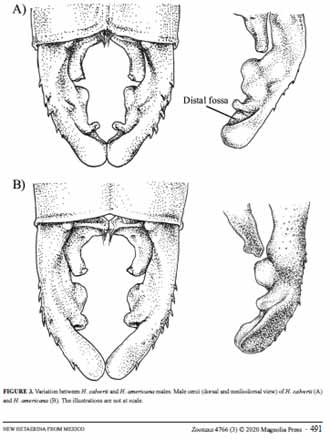
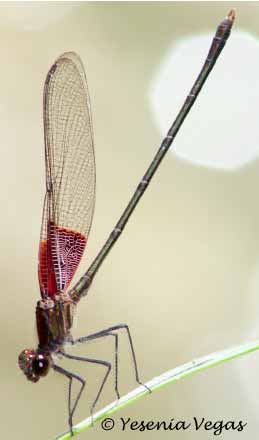
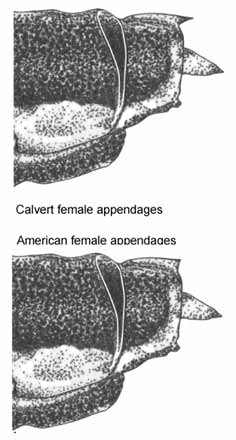
photos: appendages with comparison to American Rubyspot's appendages, male, female appendages comparison size: medium/large, length 40-46 mm male: this species just recently split from the American Rubyspot; VERY similar; differentiate by appendages and habitat female: not easily distinguishable from American Rubyspot female without a microscope similar species: almost identical to the American Rubyspot behavior: males hold territory at moving water sites; often perch with head lower than abdomen & wings held together to one side of abdomen habitat: open streams, rivers in drier habitat than where American Rubyspot is found. known Jalisco flight months: 1, 3-6, 8-10 thus far Jalisco distribution map not yet made Mexican distribution map | |
|
Canyon Rubyspot (Hetaerina vulnerata) 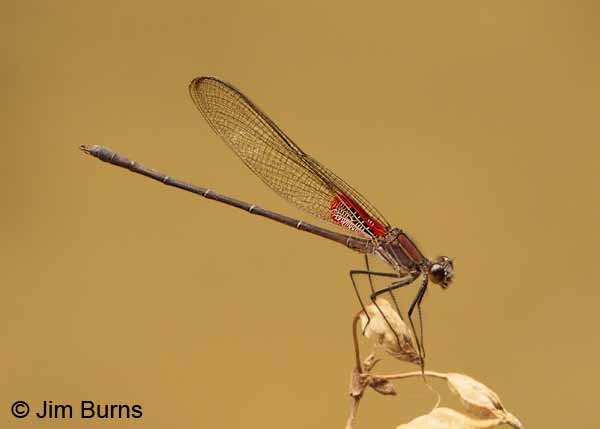
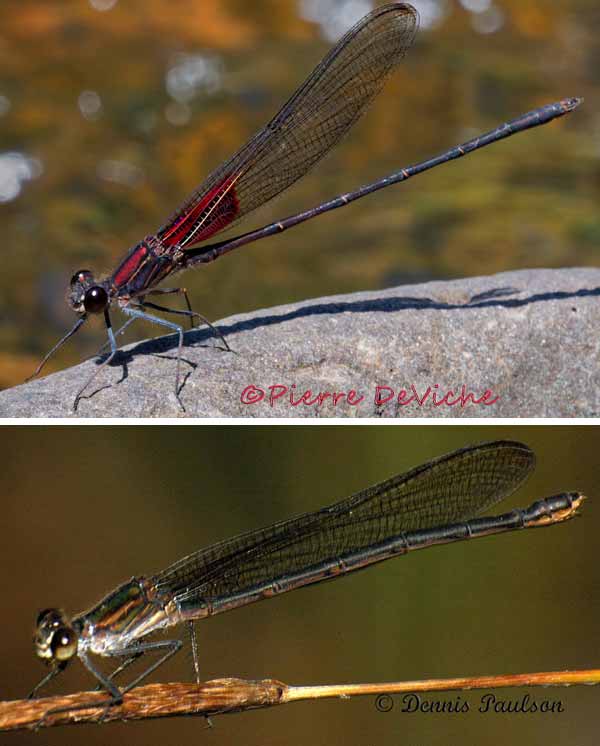
photos: males and female size: medium, length 40 - 49 mm male: red at wing base usually less extensive than American Rubyspot's; smoky edge/wing-tip; no stigma; compare by appendages - American's upper appendages have 1-2 tooth-like lobes inside at midpoint while Canyon Rubyspot's lack these lobes female: less red; thorax top metallic green; wing patches orangish, no stigma, smoky wing tips similar species: compare to American Rubyspot behavior: males hold a territory at moving water sites; usually don't hold wings together to one side of abdomen like American Rubyspot habitat: canopied streams, rivers known Jalisco flight months: 2-4, 7, 10-12 thus far Jalisco distribution map Mexican distribution map | |
Smoky Rubyspot (Hetaerina titia) 

photos: male and appendages (from side) and female size: medium/large, length 40 - 51 mm male: quite variable; in Jalisco, there is very little dark beyond the basal red in the wings but the wing tips are smoky; chestnut-colored thorax; abdomen mostly black; lower appendages curve upward female: four green spots on the top of the chestnut-colored thorax are diagnostic; pale stigma behavior: males hold territory at moving water sites; usually perch horizontally habitat: sandy-bottomed streams, rivers known Jalisco flight months: 1-3, 5-12 thus far Jalisco distribution map Mexican distribution map | |
Highland Rubyspot (Hetaerina cruentata) 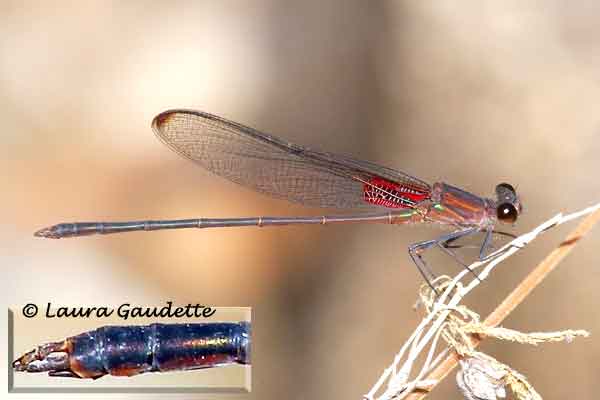
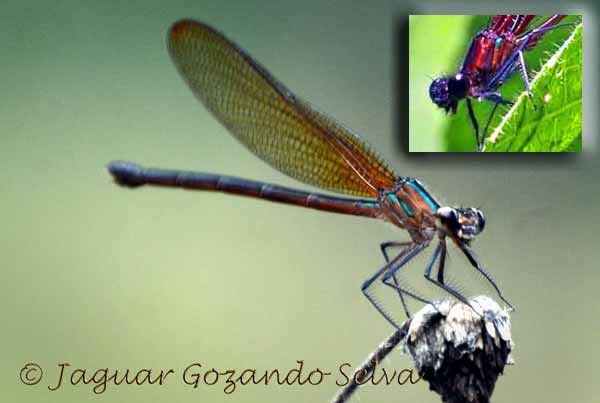
photos: males (close-up & appendages) and female size: medium, length 41-48 mm male: has red at base of wing which is also dark at the tip, there is NO stigma; the bright green triangle on the side of the thorax is diagnostic female: less colorful; wings without red, only amber wash and not dark at tip; green triangle and stripe on thorax side and top habitat: not found at lower elevations known Jalisco flight months: 1-4, 8-11 thus far Jalisco distribution map Mexican distribution map | |
Racket-tipped Rubyspot (Hetaerina occisa) 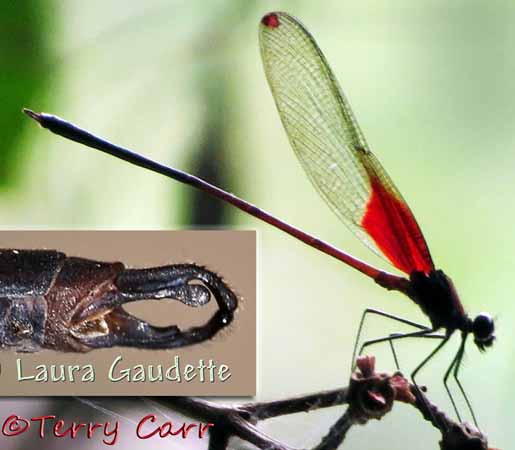
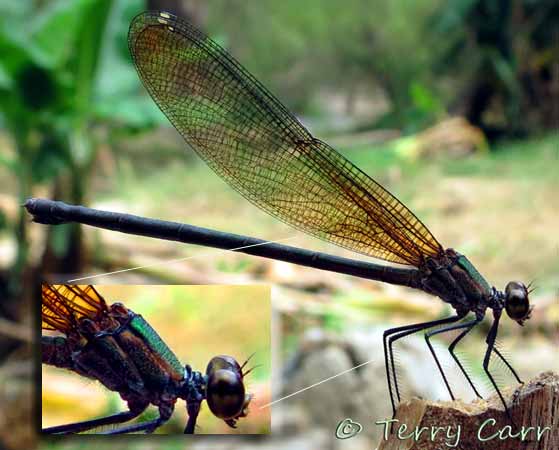
photos: male & appendages (from below) and female size medium, length 35-48 mm male: ruby red color at base of wings and distinct jewel-like red color at tip of wings; long, ratchet-shaped lower appendages female: lacks jewel-like spot at wing-tips; top of thorax with green sheen; wings slightly smoky; prothorax (neck-like area) has sideways projection which is lacking in Smoky Rubyspot females behavior: males hold territory at moving water sites; often perch with head lower than abdomen & wings sometimes held together to one side of abdomen habitat: open clear streams, rivers known Jalisco flight months: flies all year Jalisco distribution map Mexican distribution map | |
|
Bronze Rubyspot (Hetaerina capitalis) 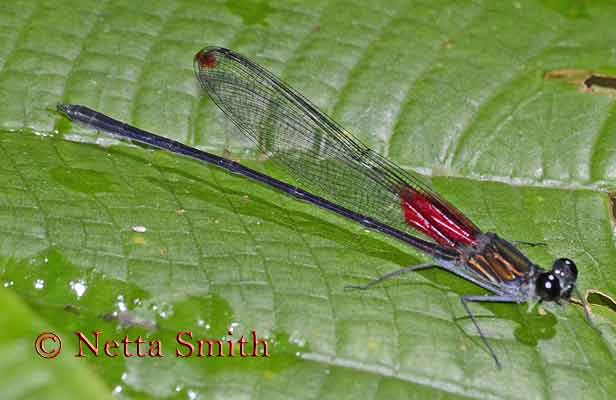


photos: males RARE in Jalisco - please report all sightings size: large, length 45 - 50 mm male:wings with stigma present, basal red hindwing patch shortened, indistinct red at tip of wing; lower appendages very short; brown thorax with thin pale stripes; large nose-like structure that lies between the eyes is metallic blue-green female: stigma present; metallic markings green; side stripe reaches thorax end; large nose-like structure that lies between the eyes is metallic green. behavior: males hold territory at moving water sites; often perch with head lower than abdomen habitat: wooded small clear streams known Jalisco flight months: 6, 7, 9, 11, 12 thus far Jalisco distribution map Mexican distribution map | |
Pond/Narrow Winged Damsels (Coenagrionidae) There are 12 genera in this family | |
|
Painted Damsel (Hesperagrion heterodoxum) 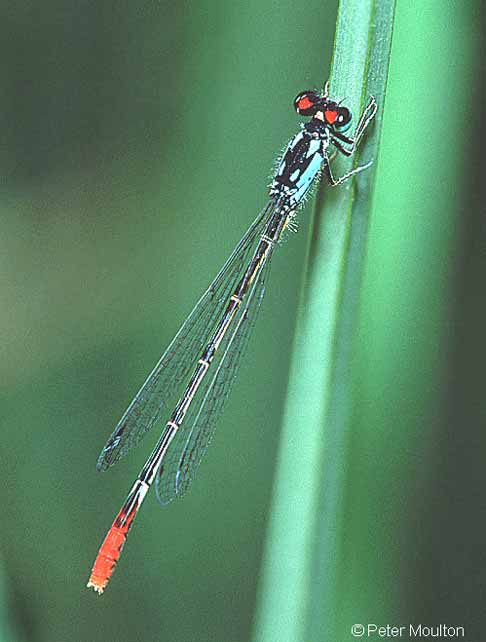
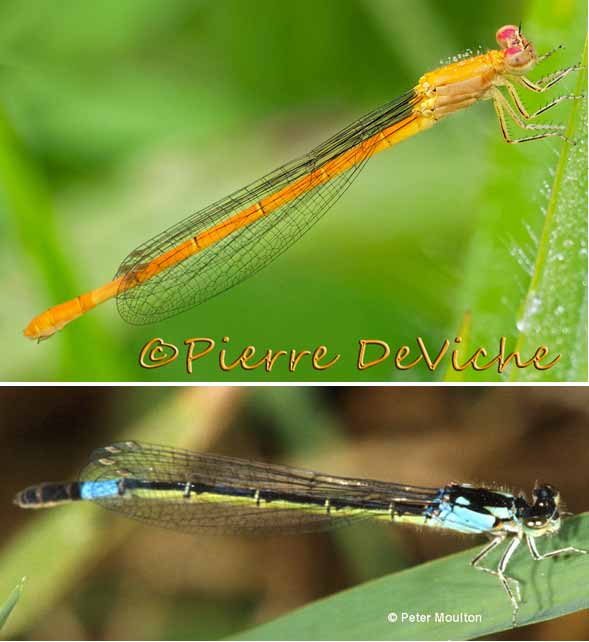
photos: male, young female, mature female size: small/medium, length 27-35 mm male: red eye spots; red top S8-10; yellow under S1-7; thorax top with 4 blue marks, sides blue, yellow brown in immature; coloration variable by age - immature all orange (image above right) female: only top of S7 blue; thorax top with blue triangles; coloration quite variable with age known Jalisco flight months: 3-5, 9, 10 thus far Jalisco distribution map Mexican distribution map | |
|
Big Red Dancer (Argia funcki) 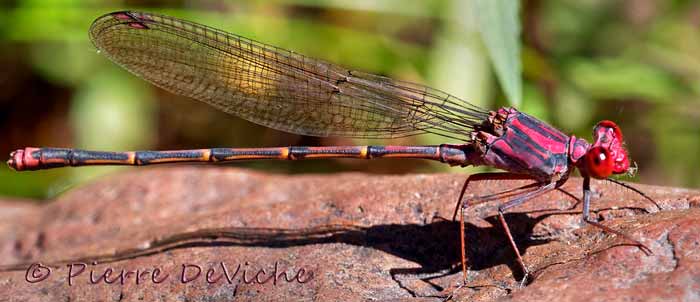
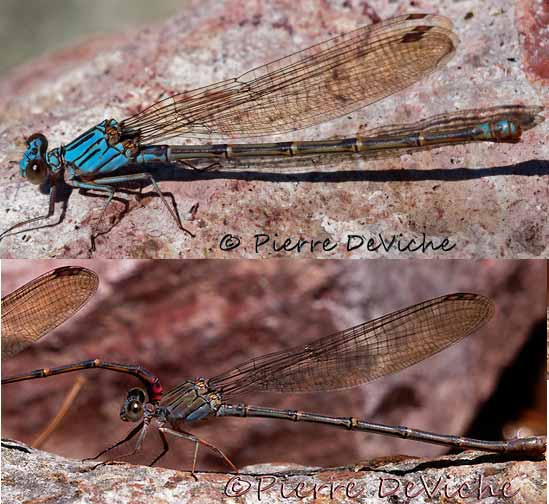
photos: male and 2 female color forms size: VERY large for a damselfly, 51-58 mm; Mexico's largest Argia male: bright red where most Dancers are blue; thorax has two parallel and unconnected, wide side stripes; abdomen tipped in red with reddish rings; stigma red in center female: several color forms, can be like male, blue or brown; stigma shows reddish color; all have a large spot atop S8 & S9 behavior: perch high above the water on trees, boulders and cliff faces; become more active as the day warms up habitat: fast moving, mid-elevation stream and rivers known Jalisco flight months: 1, 5-8 thus far Jalisco distribution map Mexican distribution map | |
Fiery-eyed Dancer (Argia oenea) 
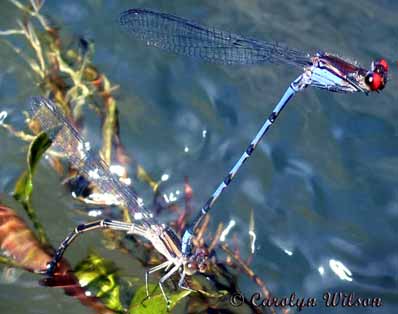
photos: male and tandem ovipositing pair size: small/medium, length 29-40 mm male: upper & front of eyes bright red; coppery orange face; top of thorax dark metallic coppery red; abdomen S3-6 blue/purple above with S8-10 all blue; wings clear female: eye color more muted if showing any red at all; tan/brown coloration; top of thorax without red; deeply forked side thoracic marks similar species: S7-appendages comparison behavior: Dancers hold their wings closed, above the body when perched, often clapping them together; females may oviposit completely submerged habitat: shallow rocky streams and rivers known Jalisco flight months: flies all year Jalisco distribution map Mexican distribution map | |
|
Amethyst Dancer (Argia pallens) 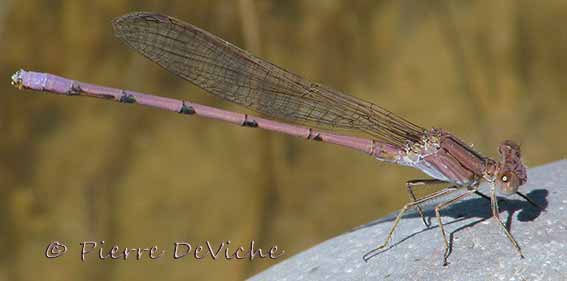

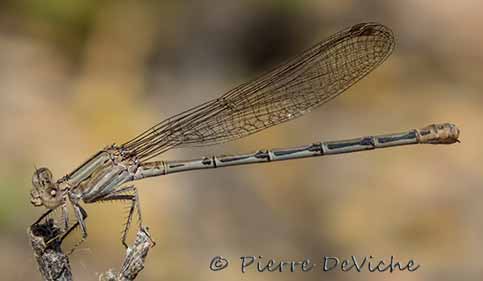
photos: males and dark form female (bottom) size: medium/small, length 22-36 mm male: almost all violet /rose & very pale, even eyes, legs & tops of S8-10; top thoracic stripe thin & narrow, dark side stripe very thin and pinched at middle; prothorax ("neck") violet; pale stigma; no triangles down side of abdomen; S7 pale, not black female: dark tan to rose similar species: S7-S10, appendages comparison habitat: creeks and streams behavior: Dancers hold their wings closed together above the abdomen; clap their wings as a warning habitat: small streams at lower altitudes known Jalisco flight months: 2-12 thus far Jalisco distribution map Mexican distribution map | |
|
Springwater Dancer (Argia funebris) 

photos: male and female size: medium, length 26-36 mm male: purple coloration; the top stripe is shaped like a coffin; unforked pinched side stripes; S4 and 5 each have a small triangle that points rearward, S8-10 unmarked pale blue similar species: Apache and Spine-tipped Dancers comparison similar species: S7-S10, appendages comparison female: like male or pale browns habitat: creeks and streams behavior: Dancers hold their wings closed, above the body when perched, often clapping them together habitat: canopied streams, seeps known Jalisco flight months: flies all year Jalisco distribution map Mexican distribution map NOTE- in 11-2022 this species and A. plana the 'Springwater Dancer' were 'lumped' because Argia plana was determined to be a junior synonym of A. funebris by Garrison & von Ellenrieder (2022). | |
|
Spine-tipped Dancer (Argia extranea) 
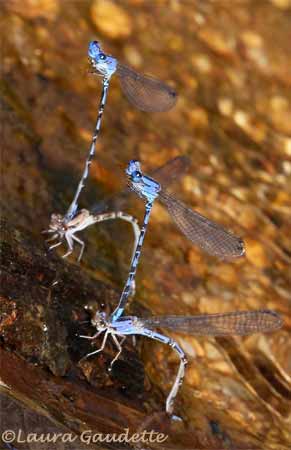
photos: male and tandem ovipositing pairs size: small, length 32-38 mm male: blue-colored or light purple with wide, parallel-sided top thoracic stripe, stair-stepped side stripe; saddle-shaped spot side of S2, S3-6 each with an isolated triangle that points backwards, S7 has blue/purple atop ~50%, S8-10 blue with thick black line along the bottom edge female: marked like male but less colorful; darker face; 2 forms, one blue & one tan similar species: Apache and Springwater Dancers comparison; S7-appendages comparison behavior: Dancers hold their wings closed, above the body when perched, often clapping them together habitat: small rocky &/or sandy streams, usually with a lot of emergent vegetation; found at elevations ranging from near sea level to 2280 m known Jalisco flight months: flies all year Jalisco distribution map Mexican distribution map | |
|
Variable Dancer (Argia fumipennis) 
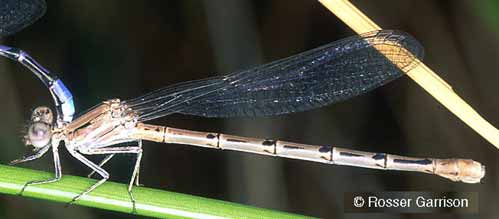
photos: male and female size: small, length 29-34 mm male: violet when mature; thoracic shoulder stripe forked; top stripe wide & straight; lower half of thorax without contrasting white; "tail end" has S8 purple with S9&10 blue, black under S8-10; sometimes slightly smoky wings female: like male but light brown or tan similar species: S7-appendages comparison behavior: prefers slow moving areas of streams habitat: slow streams, ponds known Jalisco flight months: 4, 5, 7-10 thus far Jalisco distribution map Mexican distribution map | |
Cerulean Dancer (Argia anceps) 
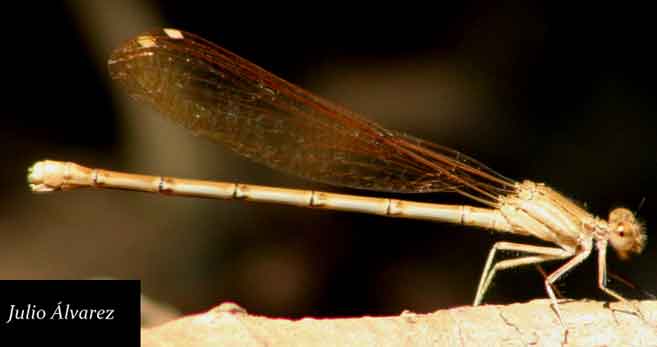
photos: male and female size: small/medium, length 34-43 mm male: bright sky blue species with very little black; wings can be amber-tinted; large eyespots; ALL the abdominal segments are blue on the top; side stripe pinched but not forked; S2 has short dark stripe on the side; appendages dark female: like male or tan; razor-thin narrow line atop thorax; simple abdomen segments with a single small mark at the rear of each; amber-tinted wings similar species: comparison with similar Sierra Madre Dancer Argia lacrimans which has clear wings but shows black atop S10; differentiate by appendages using hand lens; S7-appendages comparison behavior: Dancers hold their wings closed, above the body when perched, often clapping them together habitat: small rocky streams known Jalisco flight months: all year Jalisco distribution map Mexican distribution map | |
|
Celestial Dancer (Argia variabilis) new 2022 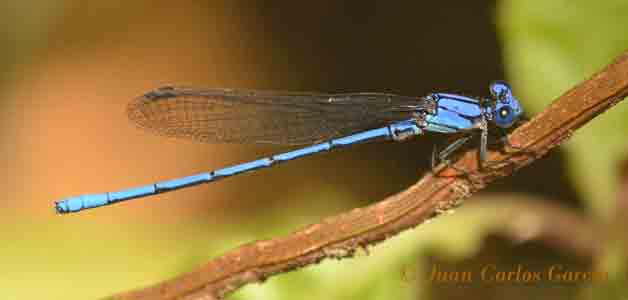
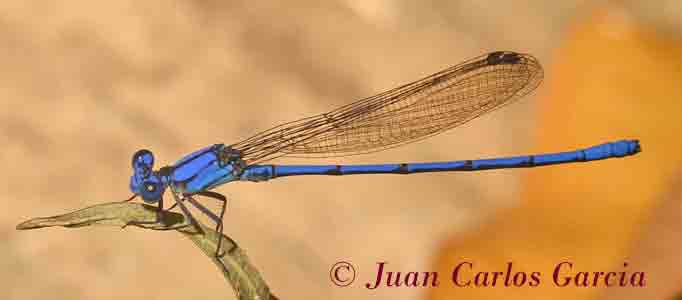

Photos: males & female drawing RARE in Jalisco, please report all sightings size: medium, length 33.6-35.7 mm male: bright sky blue species with very little black; ALL the abdominal segments are blue on the top; side stripe pinched but not forked; top stripe is narrow; S2 has short dark stripe on the side; appendages black female: blue coloration is duller, shows triangles alongside abdomen similar species: Cerulean Dancer has wider top stripe; Sierra Madre Dancer shows black between S7&8 and top stripe is wide habitat: forested areas at waterfalls known Jalisco flight months: 6, 7, 11 thus far No Jalisco distribution map Mexican distribution map | |
|
Sierra Madre Dancer (Argia lacrimans) 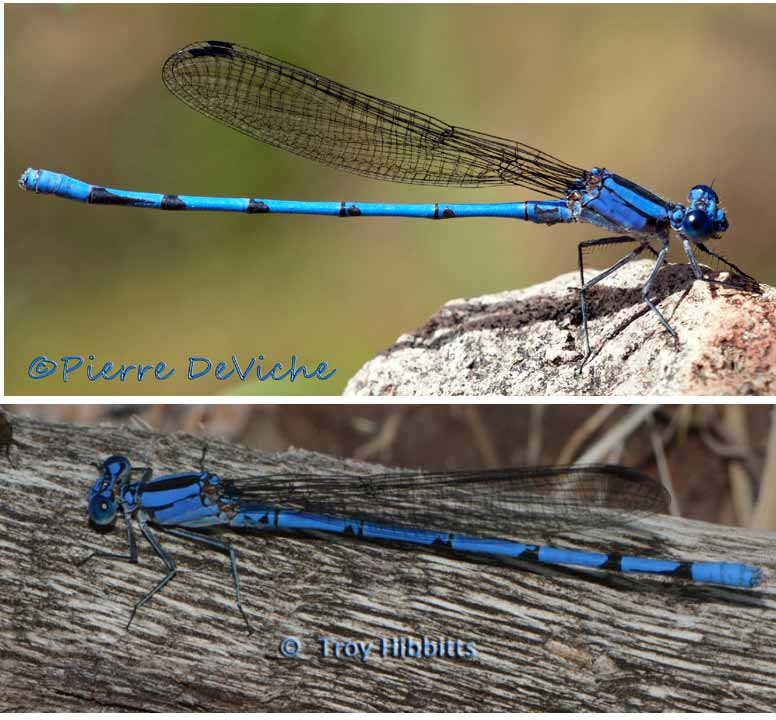
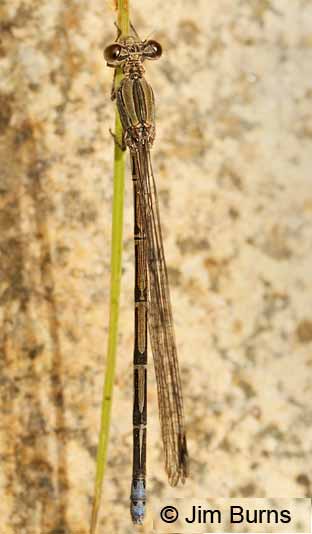
photos: males and female size: medium, length 39-44 mm male: blue and black species with clear wings; large eyespots; thorax side stripe can be pinched or forked; abdominal S3 & 4 have incomplete bands versus S5&6 which have complete bands, S8-10 blue; seen from above, the front 75% of S7 is blue; appendages light female: like male or pale browns; the humeral is forked, the median is wide; 2 large half-ovals on the top of S8 & S9; each of S3-6 has a prominent horizontal bar along its entire length that swells downward at the rear similar species: S7-appendages comparison behavior: Dancers hold their wings closed, above the body when perched, often clapping them together habitat: small rocky streams in wooded areas known Jalisco flight months: 3-11 thus far Jalisco distribution map Mexican distribution map | |
|
Harkness's Dancer (Argia harknessi) 
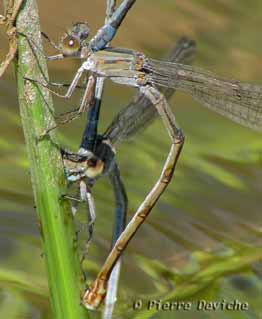
Photos: male and female size: medium/large, length 36-43 mm male: bright blue with unforked side stripe; abdomen with S7 black, S3-6 with blue points pointing towards "tail", S8-10 blue with dark lower edges female: patterned like male but points replaced by streaks behavior: Dancers hold their wings closed, above the body when perched, often clapping them together habitat: fair-sized rivers known Jalisco flight months: all year Jalisco distribution map Mexican distribution map | |
|
Apache Dancer (Argia munda) 

Photos: males and female (in tandem) size: medium, length 36-40 mm male: ground color blue; thin top and unforked side thoracic stripes, conspicuous pale line low on side of thorax gives it a bi-colored look female: like male or pale browns similar species: Springwater and Spine-tipped Dancers comparison; S7-appendages comparison behavior:Dancers hold their wings closed, above the body when perched, often clapping them together habitat: canyon streams, even intermittent known Jalisco flight months: 5,9 thus far Jalisco distribution map Mexican distribution map | |
|
Aztec Dancer (Argia nahuana) 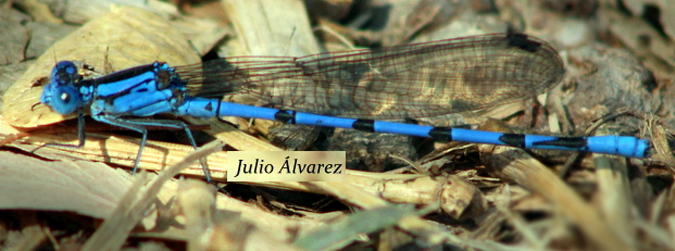

Photos: male and female size: small, length 25-35 mm male: bright sky-blue; thorax shoulder stripe variably forked (lower stripe can be interrupted); abdomen with complete balck rings on 3-6. tiny blue spot inside the rings; blue on S8-10 with thin black line at bottom; distance between lower appendages from above less than width of individual appendages; usually a spot, rather than a dash, on S2 side female: less colorful, thicker bodied than male; one form like male; other is tan and black similar species: S7-appendages comparison behavior: Dancers hold their wings closed, above the body when perched, often clapping them together habitat: slow waters known Jalisco flight months: 4-7, 9 thus far Jalisco distribution map Mexican distribution map | |
|
*Anna's Dancer (Argia annae) (*=proposed name) 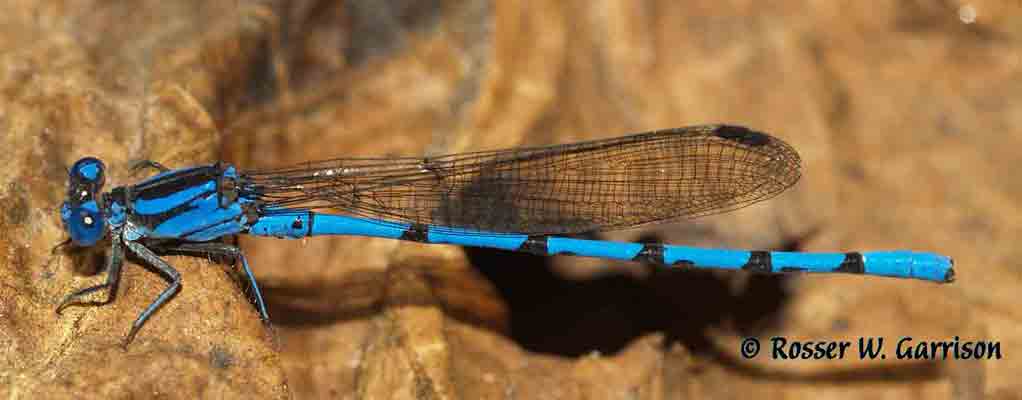

photos: male and drawing of a female RARE in Jalisco - please report all sightings size: medium, length 38-39 mm male: bright blue-colored; large blue postocular eye spots triangular in shape and not connected by an occipital bar; black thoracic side stripe forked; blue atop all abdominal segments with S2 having an irregular triangular black spot, S4-7 with side spots, S7 mostly blue. no black stripe under S8–9; wings clear female: similar to male but pale colors a lighter blue; head with more extensive black behavior: Dancers hold their wings closed, above the body when perched, often clapping them together habitat: roadside seepages at elevations from about 40 to 1830 m. known Jalisco flight month: 9 No Jalisco distribution map yet! Mexican distribution map | |
|
Yaqui Dancer (Argia carlcooki) VULNERABLE SPECIES (G2G4) 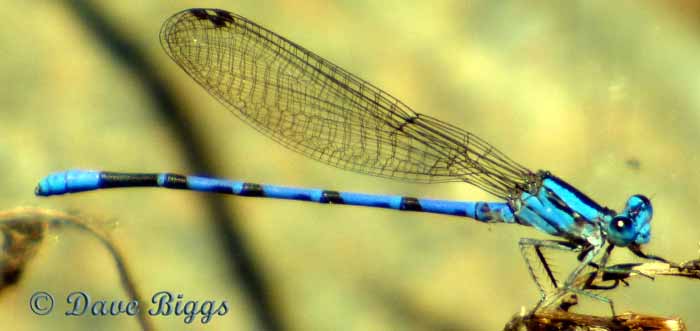
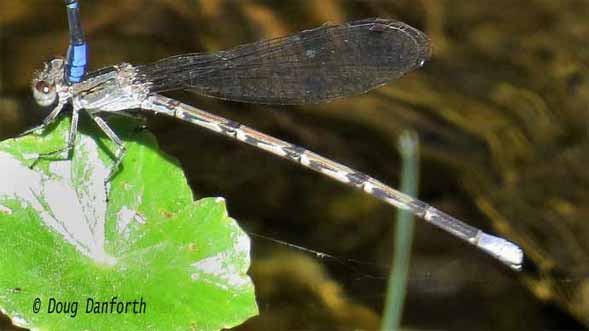
photos: male and female size: small, length 31-32 mm male: blue-colored with thickly-forked side thoracic stripe; S3-6 have long dark triangles along side, S8-10 blue on top and sides and black underneath, S7 all dark female: more strongly marked than male behavior: Dancers hold their wings closed, above the body when perched, often clapping them together habitat: lushly vegetated streams known Jalisco flight months: flies all year Jalisco distribution map Mexican distribution map | |
|
Tarascan Dancer (Argia tarascana) 
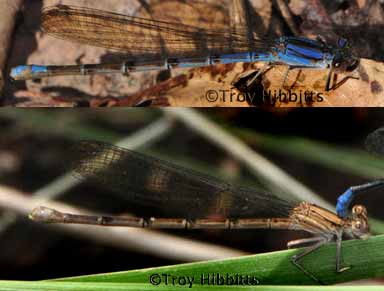
photos:male and 2 females; size: medium, length 33-41 mm male: blue and black species with wide, variably forked side stripe, top split forms a backwards pointing arrow; large eyespots; abdominal S3-6 each have a black band covering less than 1/3 of the segment, S8-10 blue female: like male or pale browns similar species: S7-appendages comparison behavior: Dancers hold their wings closed, above the body when perched, often clapping them together habitat: streams, ditches known Jalisco flight months: 6?, 7-9, 11, 12 thus far Jalisco distribution map Mexican distribution map | |
|
Sabino Dancer (Argia sabino) 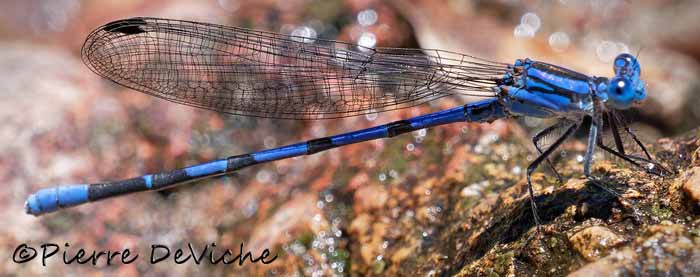

photos: male and female; RARE in Jalisco - please report all sightings size: medium, length 33-41 mm male: g///blue coloration; side stripe wide and forked with an "island" of color at end; S3-5 have a complete black band at the rear that covers about 1/3 of the segment; S6 is 50/50 black & blue, S7 all black on top female: similar to male but tan and light blue or tan and dark with ringed abdomen similar species: S7-appendages comparison behavior: Dancers hold their wings closed, above the body when perched, often clapping them together habitat: pools near waterfalls; streams with large boulders known Jalisco flight months: 8 thus far Jalisco distribution map not yet made Mexican distribution map | |
|
Oculate (Bluepoint) Dancer (Argia oculata) 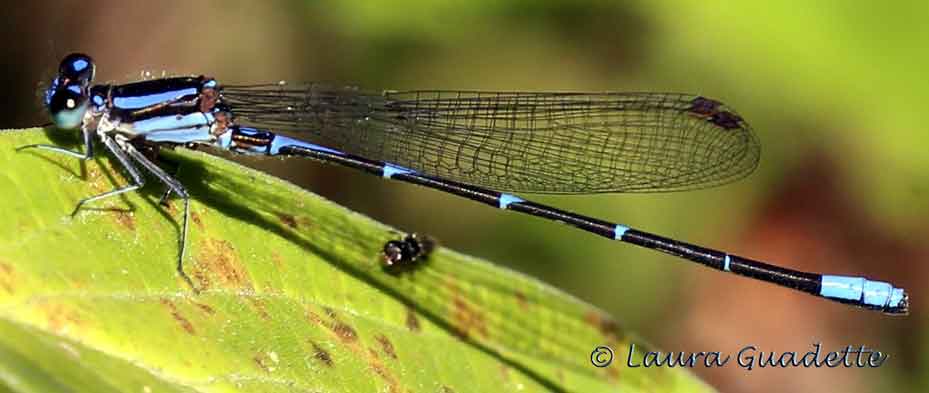
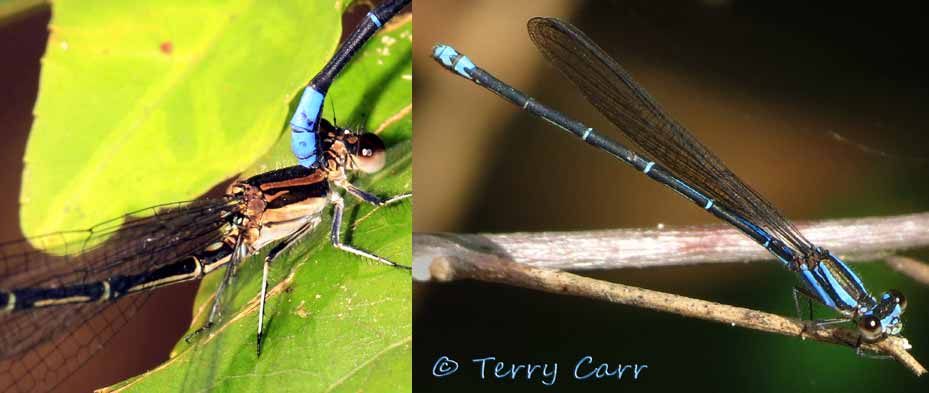
photos: male and tandem pair, male-like female size: small/medium, 31-41 mm male: abdomen mostly dark with backwards pointing blue arrows atop the segments nearest the thorax; side thoracic stripe wide and forked; "tail" black on underside with blue on top of S8-10 female: thorax like male, but abdomens with rings, not points. Blue and tan forms similar species: S7-appendages comparison behavior: Dancers hold their wings closed, above the body when perched, often clapping them together habitat: ponds; slow moving water known Jalisco flight months: flies all year Jalisco distribution map Mexican distribution map Note: formerly called the Blue-point Dancer | |
|
Olmec Dancer (Argia ulmeca) new species for Jalisco 2020 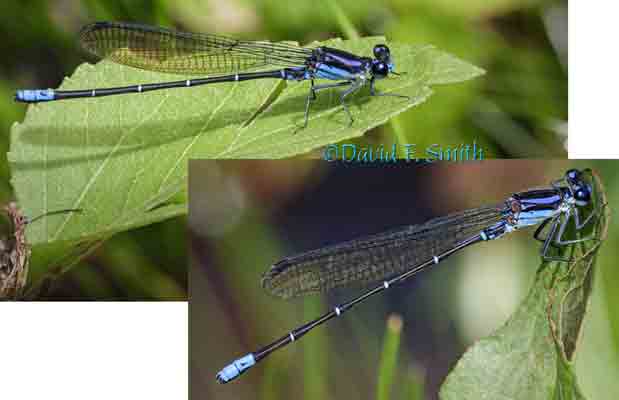

photos: males and in tandem with female RARE in Jalisco - please report any sightings size: large, length 34-45 mm male: thorax blue/purple-colored with thickly-forked side thoracic stripe that is narrowed at the upper end, wide top stripe; abdomen black with thin pale ring at each segment, S8-10 blue with distinctive black marks on S8; wings can show tinting female: a little smaller, tan where male is blue and with pale side streaks on abdomen similar species: Oculate Dancer has blue points on S3-5; Purple Dancer has eye spots connected by a bar behavior: Dancers hold their wings closed, above the body, often clapping them together; they often return to the same perch after flying out for prey habitat: mid-elevation rocky streams in pine/oak forests known Jalisco flight months: 7 thus far Jalisco distribution map Mexican distribution map | |
|
Tezpi Dancer (Argia tezpi) 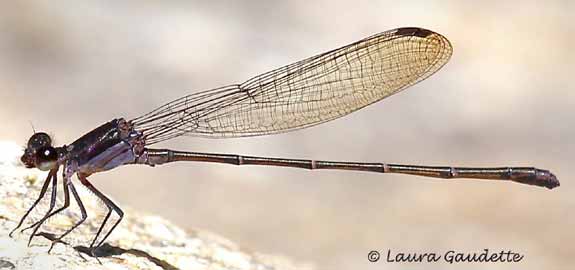


photos: male, blue female and tandem pair size: medium, length 36 - 42 mm male: very dark, even the face and eyes, eye-spots not very noticeable; thorax top all dark; wings golden; all dark abdomen including S7-10 with 4 pale rings around segments female: like male or brown; split thoracic side stripe similar species: see comparison to Dusky Dancer & others; S7-appendages comparison habitat ponds & slow moving water behavior: Dancers hold their wings closed, above the body when perched, often clapping them together khown Jalisco flight months: flies all year Jalisco distribution map Mexican distribution map | |
|
Dusky Dancer (Argia translata) 

photos: male and female RARE in Jalisco - please report any sightings size: medium, length 30-43 mm male: very dark with pale rings and no blue on the 'tail'; purplish tint to the body and luscious eyes; side stripe doubled and joined at the base; some cream color low on S8-10 female: like male or light tan; lack the luscious eyes similar species: see comparison to Tezpi Dancer & others; S7-appendages comparison behavior: Dancers hold their wings closed, above the body when perched, often clapping them together habitat: rivers known Jalisco flight months: 6, 8 thus far Jalisco distribution map Mexican distribution map | |
|
Powdered Dancer (Argia moesta) 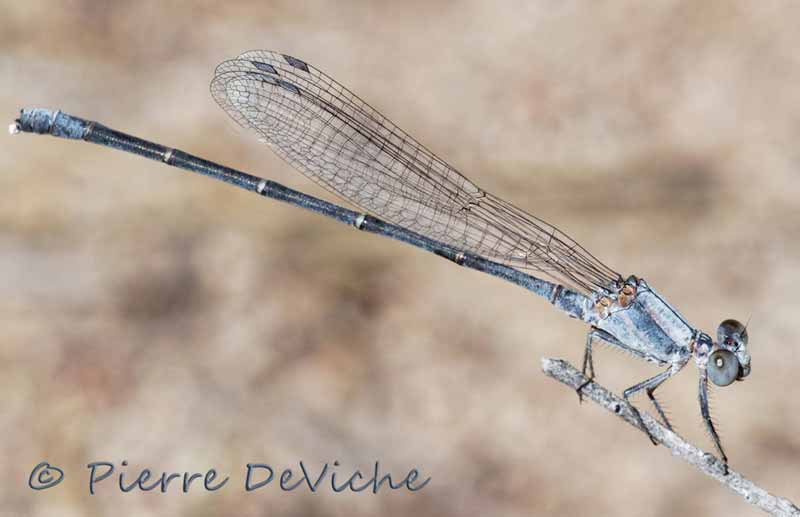
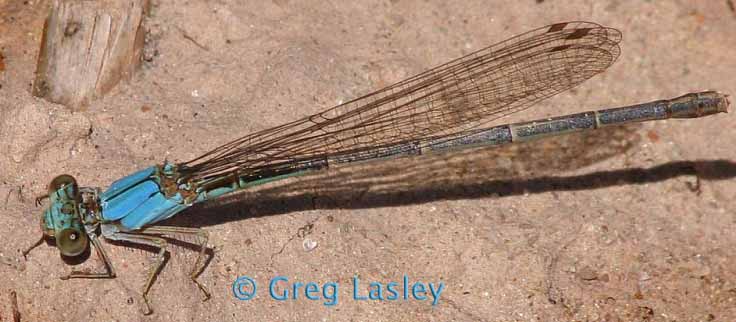

photos: male and both color forms of females; RARE in Jalisco - please report all sightings size: medium, length 37-44 mm male: develops chalky/powdery white/gray pruinosity with age, especially thorax; abdomen turns pruinose gray on S8-10 female: pale blue or light brown thorax; older females sometimes become a bit pruinose similar species: S7-appendages comparison behavior: Dancers hold their wings closed, above the body when perched, often clapping them together habitat:rocky rivers, windy lakes known Jalisco flight months: 8, 9 thus far Jalisco distribution map not yet made Mexican distribution map | |
Purple Dancer (Argia pulla) 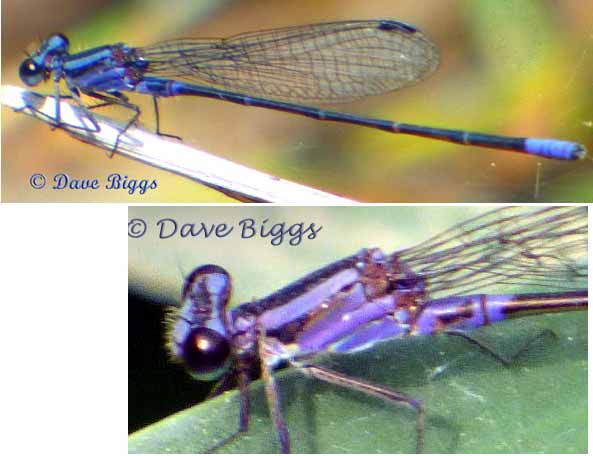
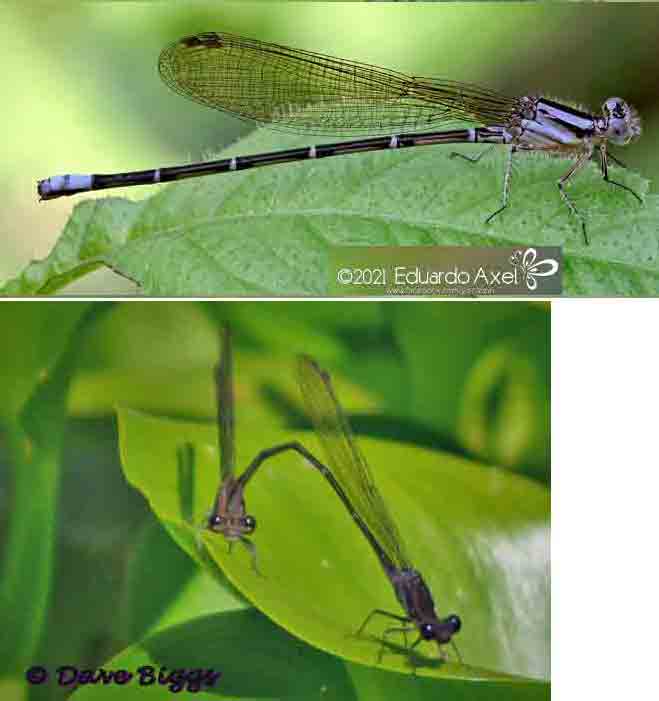
photos: male and female size:small/medium, 25-36 mm male: purple ground color; dark abdomen with thin pale rings and purple tip; thorax with wide side stripe; dark blue eyes have connected purple eye-spots female: broader humeral stripe similar species: the eyes are black above and green below in A. frequentula which has not yet been confirmed in the state behavior: Dancers hold their wings closed, above the body when perched, often clapping them together habitat ponds & slow moving water known Jalisco flight months: flies all year Jalisco distribution map Mexican distribution map | |
|
May's Dancer (Argia mayi) 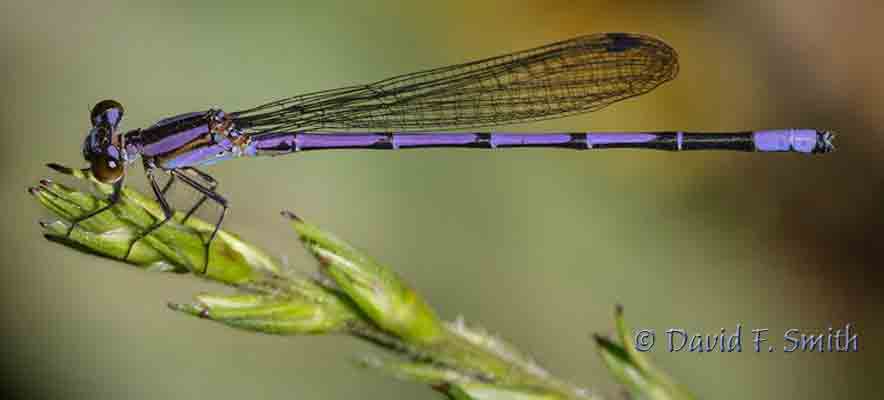

 
photos: males and drawings of Argia mayi; RARE in Jalisco - please report all sightings size: medium, 28-37 mm male: overall purple coloration, inc. on the top of S1-6, unusual in that the coloration on the top of tail tip is restricted to S8-9, S7 & often S10 are all black; the pale thoracic side stripe appears pinched near the abdominal end, the top dark stripe is parallel sided and wide, the dark side stripe is wide, with the lower sides of the abdomen paler; the eyespots are somewhat triangular in shape and connected by a thin bar female: the mesostigmal plate (neck-like behind head) has erect hind margin similar species: Argia fumipennis has S10 pale on top, no other male Argia in Jalisco has S10 dark habitat: mid-elevation clear running streams, endemic to Mexico known Jalisco flight months: 8&9 thus far Jalisco distribution map not yet made Mexican distribution map | |
|
Neotropical Bluet (Enallagma novaehispaniae) 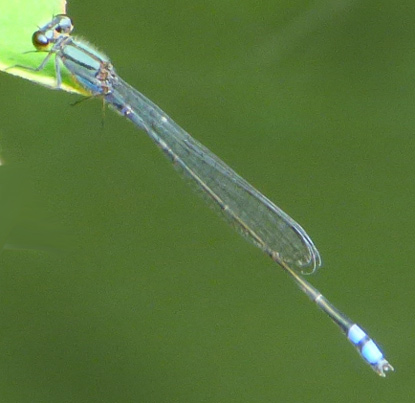
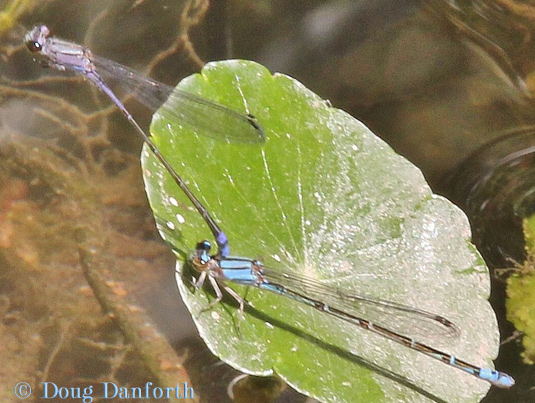
photos: male and tandem pair size: medium, length 29-35 mm male: thorax blue or purple-blue, top stripe and side stripe parallel-sided and about the same width; large oval eye spots; long abdomen with blue atop S8 & 9 often separated by a dark ring; top appendages forked & extend considerably beyond lower appendages similar species: E. semicirculare has color atop S4 female: one form like male or somewhat green; other mostly brown behavior: Bluets hold their wings closed, alongside the body when perched habitat: heavily vegetated streams known Jalisco flight months: 1-6, 9, 10, 12 thus far Jalisco distribution map Mexican distribution map | |
|
Claw-tipped Bluet (Enallagma semicirculare) 

photos: male and female size: medium, length 30-32 mm male: blue or purple with very long, smooth upper appendages that extend considerably beyond lower appendages; S7-9 blue/purple; Blue/purple atop S2-4; top thoracic black stripe wider than side stripe similar species: E. novaehispaniae does not have color atop S4 female: like male but more blue behavior: Bluets hold their wings closed, alongside the body when perched habitat: heavily vegetated slow streams and ponds known Jalisco flight months: 1, 2, 4, 5, 7-9, 12 thus far Jalisco distribution map Mexican distribution map | |
|
Familiar Bluet (Enallagma civile) 

photos: male and female size: small/medium, length 28-39 mm male: markings more blue than black, S3-5 are mostly blue; top thorax stripe dark; small comma-shaped eyespots; top appendages longer than lowers, large and fin-like with pale "button," appear splayed female: like male or tan and black similar species: Arroyo Bluet has S4&5 mostly black and forked upper appendages. Comparison site behavior: Bluets usually hold their wings alongside abdomen and fly low over water along shoreline or over submerged vegetation habitat: still waters with nearby fields known Jalisco flight months: 2-12 thus far Jalisco distribution map Mexican distribution map | |
|
Arroyo Bluet (Enallagma praevarum) 

photos: male, appendages and tandem pair size: small, length 26-37 mm male: S4-7 more black than blue with each segment usually 50% darker than the preceding one; S3 usually more than 50% black, S8 & 9 blue; thorax top stripe dark; forked upper appendage female: pale areas blue or tan; no blue on tail similar species: Familiar Bluet has S4-7 more blue than black. Comparison site behavior: Bluets usually hold their wings alongside abdomen rather than sail-like over their abdomen habitat: lakes, ponds, streams known Jalisco flight months: 3-11 thus far Jalisco distribution map Mexican distribution map | |
West Mexican Yellowface (Neoerythromma gladiolatum) 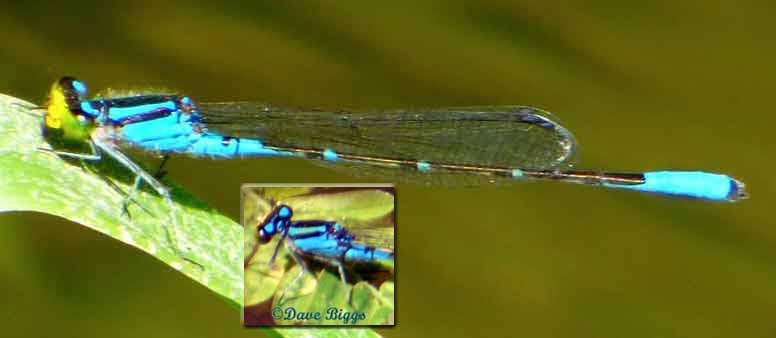
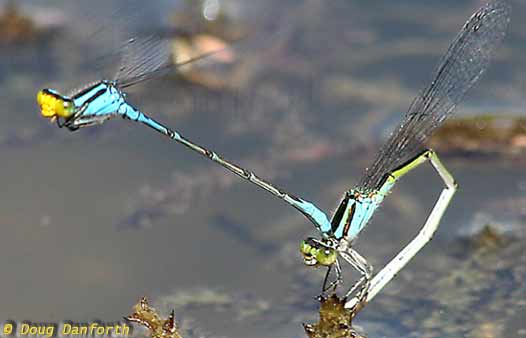
photos: male & view from rear (insert) and ovipositing pair size: small; length 28 - 31 mm male: uniquely yellow on face; resembles a bright blue Bluet but with blue on 3 of the tail segments, including S7-9; wedge-shaped appendages female: like male but with dull yellow-green face similar species: like Bluets (Enallagma) but there are no Bluets with yellow faces; or as much blue on tail; Caribbean Yellowface (N. cultellatum) has S7 all black and isn't expected in Jalisco habitat: ponds, flooded lagoons especially with grasses and sedges known Jalisco flight months: 2, 3, 5-11 thus far Jalisco distribution map Mexican distribution map hint: When you cannot see the face, look for the 3+ blue tail-end segments to distinquish it from Ennalagma species | |
|
Mexican Forktail (Ischnura demorsa) 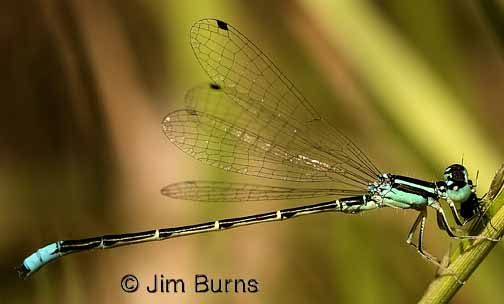
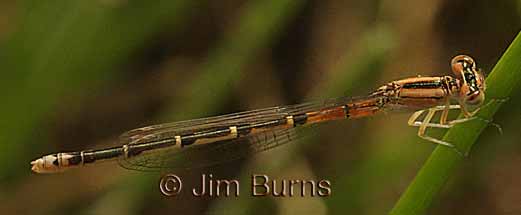
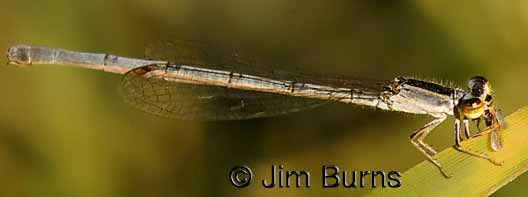
photos: male, immature and mature female size: small, length 21-33 mm male: thorax sides & top have blue-green stripes; noticeable fine pale rings across each dark abdomen segment; blue tip has dark intrusions on sides; dual "forks" atop S10 are pale tipped female: immature orange & black with S1-3 mostly orange; becomes all pale pruinose similar species: Rambur's and Tiny Forktail lack black intrusion on S8 and have narrower blue/green stripes on thorax, Citrine Forkail male appendages different; compare Citrine vs Mexican Forktail (females) habitat: weedy ponds, creeks known Jalisco flight months: all year Jalisco distribution map Mexican distribution map | |
Rambur's Forktail (Ischnura ramburii 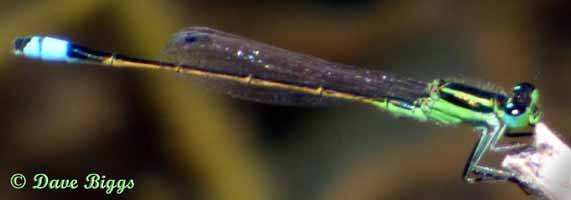

photos: male & immature female size: medium, length 27 - 36 mm male: green-blue shoulder stripe very thin, parallel sided; tiny circular eyespots not connected with a bar; thorax and S1-3 greenish-blue; yellowish-orange underside only of S3-7; blue surrounds S8, part of 9, not top of 10; lower appendages point straight out female: very male-like or Day-Glo red/orange turning tan/olive; wide black stripe thorax top similar species: Citrine Forktail female's abdomen not all black; Mexican Forktail male is similar with much larger fork atop end of S10https://azdragonfly.org/comparison/desert-vs-ramburs-forktail habitat: ponds & slow moving water known Jalisco flight months: all year Jalisco distribution map Mexican distribution map | |
|
Tiny Forktail (Ischnura capreolus) 
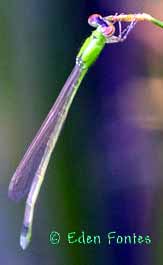
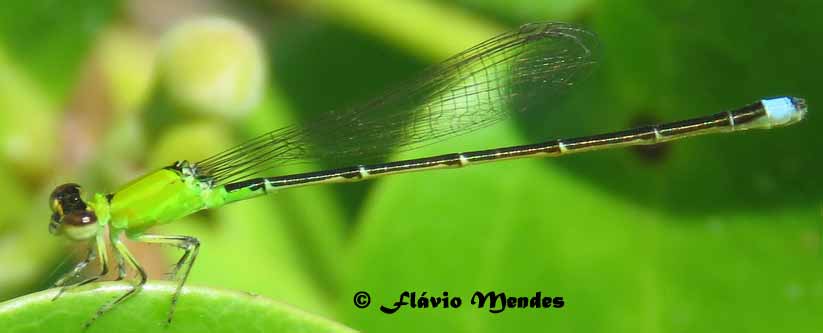
photos: mature male, appendages [insert], immature females size: very small, length ~22 mm male: like Rambur's Forktail but smaller with less blue on tail, a larger fork on S10, lower appendages forked with the lower fork the longest female: lime green/yellow, blue S9 only similar species: Rambur's Forktail female is without green; Mexican Forktail male is similar but with a much larger fork atop end of S10 habitat: dense grass/sedge areas in marshes or at the edge of ponds known Jalisco flight months: 4, 6-10 thus far Jalisco distribution map not yet made Mexican distribution map | |
|
Black-fronted Forktail (Ischnura denticollis) 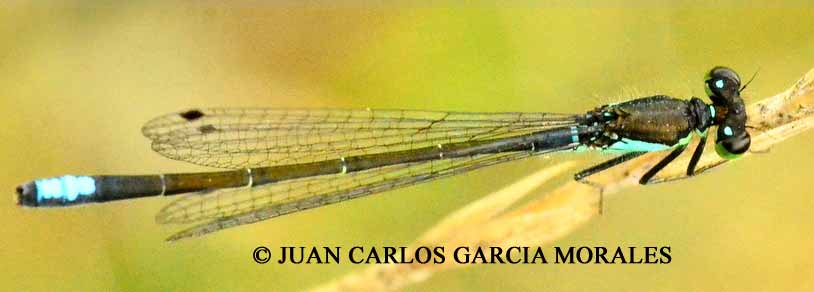
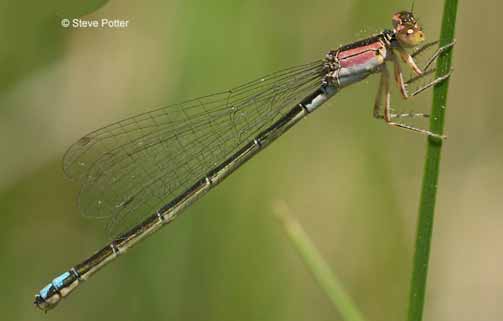
photos: male and young female size: very small, length 22-26 mm male:no stripes or dots top of thorax; all dark above, sides of thorax blue (green in immature); blue patches on top & bottom segments 8-9 do not touch; chartreuse underside; frail; upper appendages bent down; stigma has white margin at rear female:thorax sides pale coral but when mature green/blue thorax sides behavior: Forktails hold their wings anyway they want to! habitat:lakes, ponds, seeps known Jalisco flight months: 3, 5, 7, 8, 10, 11 thus far Jalisco distribution map Mexican distribution map | |
Citrine Forktail (Ischnura hastata) 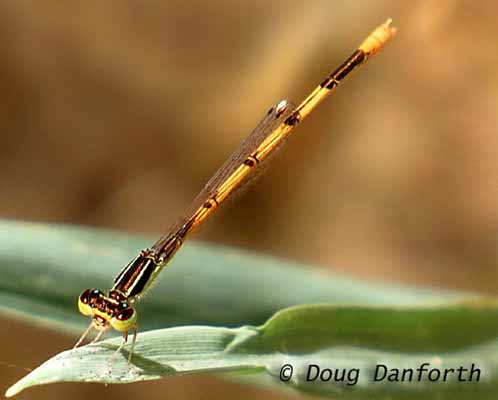
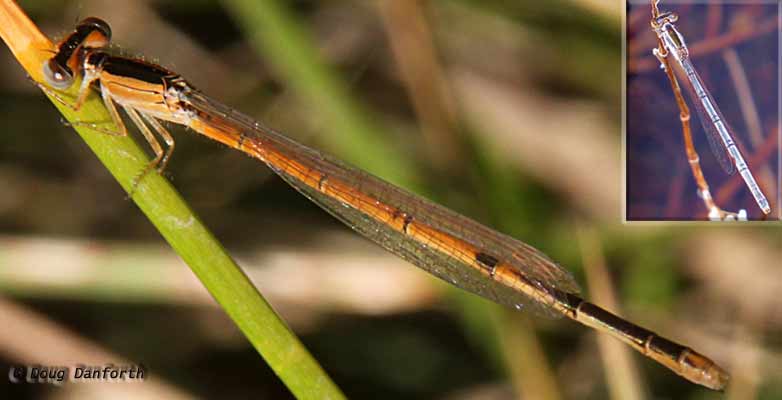
photos: male & immature and mature (insert) females size:small; length 21 - 25 mm male: uniquely yellow on abdomen; yellow face; stigma one cell away from leading edge on front wing female: wide black stripe thorax top both in pruinose mature form and immature orange form similar species: Mexican Forktail mature female lacks dark top stripe; Mexican Forktail male is similar with much larger fork atop end of S10 habitat: ponds, flooded lagoons; slow moving water known Jalisco flight months: 1-6, 8-12 thus far Jalisco distribution map Mexican distribution map | |
|
Black and White Damsel (Apanisagrion lais) 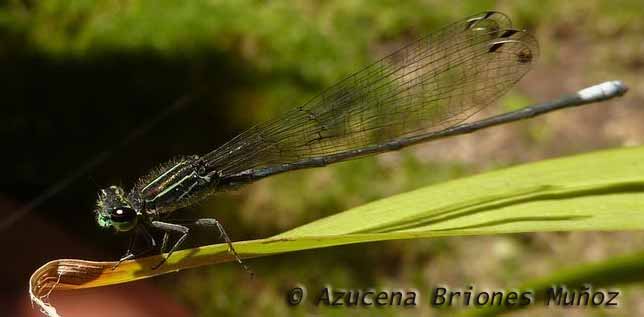
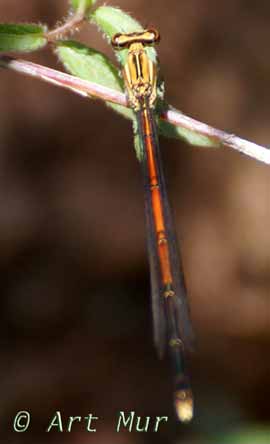
photos: male and immature female size: medium, length 35-38 mm male: mostly dark with thin green lines atop thorax and pale pruinosity atop S8-10; dark smudge-like look at wingtip is diagnostic; immature males look like young females female: bright orange when immature; male-like when mature behavior: hovers in the shade; seen mostly in the mornings habitat: wet margins of canopied streams and seeps known Jalisco flight months: flies all year Jalisco distribution map Mexican distribution map | |
Orange-striped Threadtail (Protoneura cara) 

photos: tandem pairs ovipositing size: small, extremely thin; length 33-37 mm male & female: both have very thin dark abdomens with pale rings; on males the thorax, eyes and face show more orange behavior: females bend at extreme angles to oviposit, needing to 'park' their very long abdomens between their wings for stability habitat: ponds and pools of rivers with abundant underwater vegetation reaching the surface known Jalisco flight months: flies all year Jalisco distribution map Mexican distribution map | |
|
Amelia's Threadtail (Neoneura amelia) 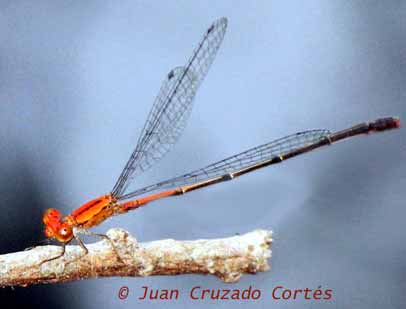

photos: male and tandem pair RARE in Jalisco - please report any sightings size: small, extremely thin; length 31-34 mm male: very thin body with red head, thorax and first 3 abdominal segments, rest of abdomen black with thin pale rings female: like male but light olive replaces red except for eye-spots behavior: tandem oviposit; females bend at extreme angles to oviposit, needing to "park" their very long abdomens between their wings for stability habitat: ponds and river pools with abundant underwater vegetation reaching the surface known Jalisco flight months: 6, 7, 9, 10, 12 thus far Jalisco distribution map not yet made Mexican distribution map | |
|
Ruddy Threadtail (Protoneura rojiza) 
photos: drawings of male and female, appendages as described by Gonzales; González Soriano, E., 1992 - Protoneura rojiza spec. nov., a new damselfly from Mexico (Zygoptera: Protoneuridae). Odonatologica 21 (4): 489-493, figs. 1-8. RARE in Jalisco - please report any sightings size: medium (but larger than other Threadtails in Jalisco), extremely thin, length 39-43 mm male: black head with ivory "face"; thorax black with narrow red line, outer legs black, wings yellowish; blood red abdomen with dark markings atop the segments female: like male but stripes on S1-2 yellow and abdomen reddish-brown except S7-10 black habitat: inland streams known Jalisco flight months: 7 thus far Jalisco distribution map not yet made Mexican distribution map | |
Desert Firetail (Telebasis salva) 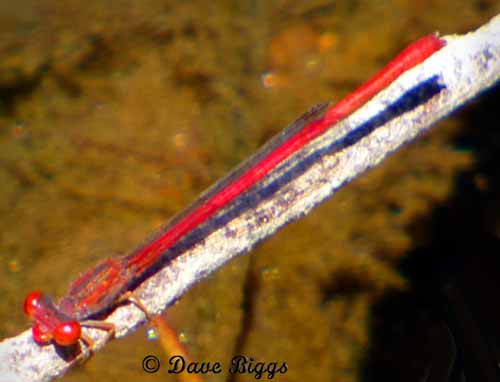
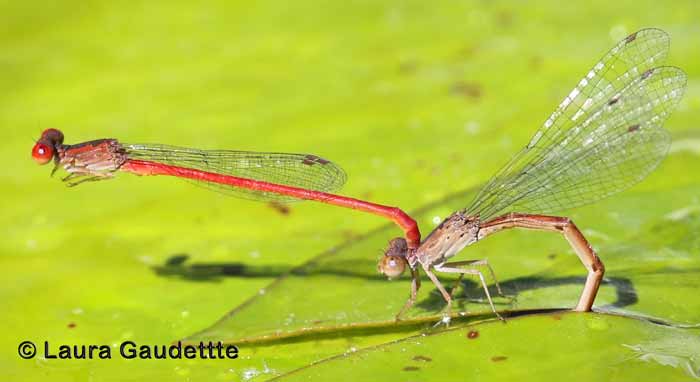
photos: male & tandem ovipositing pair size: very small, length 23 - 29 mm male: dainty and slender; all red abdomen extends well beyond wing tips, tip of abdomen without black; red face and eyes; black eye spots; thorax red with black; pale legs female: similarly marked; colored from brown to tan to orange-red behavior: tandem oviposit; eggs laid in algae mats and floating decomposing vegetation habitat: shallow waters with algae scum &/or floating decomposing vegetation; lowlands known Jalisco flight months: flies all year Jalisco distribution map Mexican distribution map | |
|
Hyacinth Firetail (Telebasis levis) 

photos: male and female size: small/medium, length 28-32 mm male: top of thorax dark, lower thorax lighter female: like male, or lacks red; top of thorax dark but without dark sheen behavior: usually found on ponds and not far from them habitat: ponds with many water hyacinths known Jalisco flight months: 5-11 thus far Jalisco distribution map Mexican distribution map | |
Striped Firetail (Telebasis filiola) 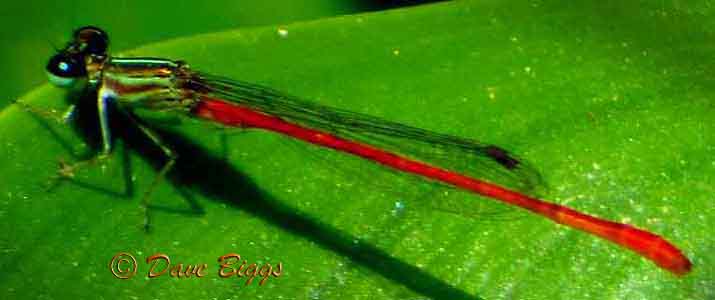

photos: male & tandem pair size: VERY small, length 20 - 26 mm male: dainty and slender; all red abdomen extends well beyond wing tips; blue-green face and bottoms of eyes; thorax black with pale blue-green stripes; tip of abdomen without black female: head and thorax like male; abdomen dark habitat: small weedy ponds and marshes, esp. with water hyacinth known Jalisco flight months: 1-7, 9-12 thus far Jalisco distribution map Mexican distribution map | |
|
Middle American Pearlwing (Anisagrion allopterum) 

photos: male, mature and immature female RARE in Jalisco - please report any sightings size: lenght, small/medium,~32 mm male: abdomen all black on top with noticeable blue under S1-4, thin pale rings S2-6 only; tail end can be all black on top with blue on underside or show blue atop S8, lower appendages extend noticeably beyond abdomen tip, forktail-like spikes atop S10; thorax with thick black stripe on top, side dark stripe thicker at front end; small stigma with a hint of white female: when young orange with dark near end of abdomen, there is much color variation with age habitat: mid-elevation wetlands including marshy ponds and slow streams in or out of forest known Jalisco flight months: 4, 8, 9, 11 thus far Jalisco distribution map Mexican distribution map | |
|
Red-tipped Swampdamsel (Leptobasis vacillans) 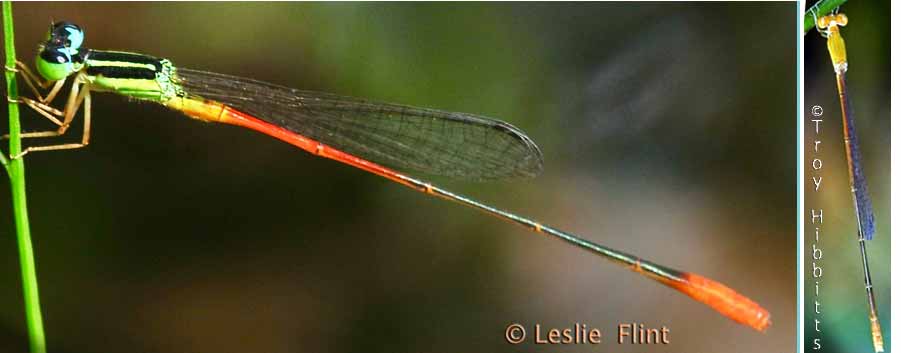
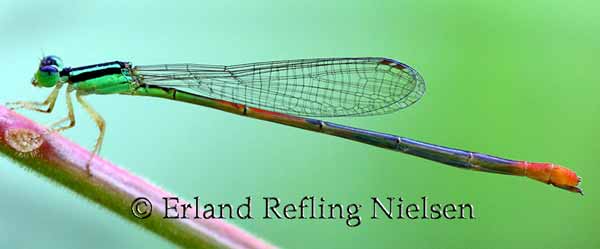

photos: mature male, immatures and female; RARE in Jalisco - please report any sightings size: medium but thin and long, length ~33 mm male: when mature, thin green stripes on thorax, legs without black bands; abdomen red, green and dark with red tip S8-10 female: change greatly as they age, if they live long enough, they are male-like; large ovipositor habitat: presumably swamps known Jalisco flight months: 7, 8 Jalisco distribution map Mexican distribution map | |
|
Cream-tipped Swampdamsel (Leptobasis melinogaster) 
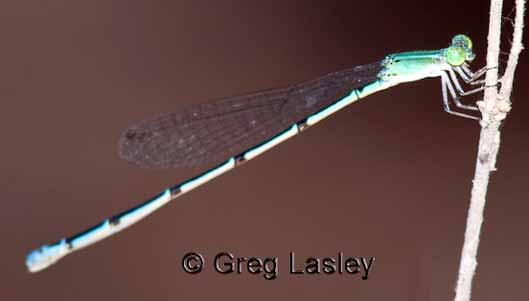
photos: male and female; RARE in Jalisco - please report any sightings size: medium but thin, long, length 38-40 mm male: green eyes & eye-spots; green stripes on thorax, black bands on legs; long, thin dark abdomen with tiny rings and pale pruinosity S7-10 female: shorter abdomen than male, with conspicuous dark rings; no pruinosity; pale blue-green on thorax habitat: shaded pools in slow moving streams, especially with tall grasses known Jalisco flight months: 1, 7, 8 thus far Jalisco distribution map Mexican distribution map | |
Lemon-tipped Helicopter (Mecistogaster ornata) 
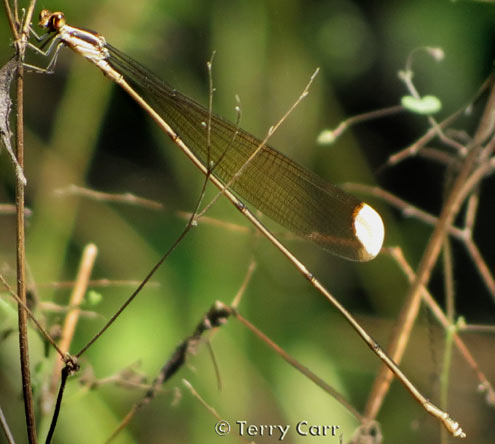
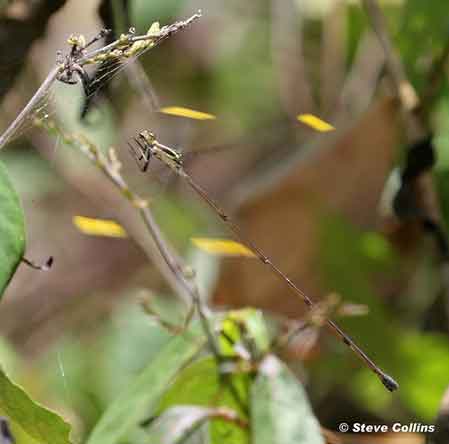
photos: scan of mature male & female, young male, female in flight size: length, VERY LONG/SLENDER 73-102 mm male: very long abdomens; in breeding season the male's wingtips turn from pale yellow to dark brown female: wing-tips yellow; very long abdomens behavior: when flying, only the colored wingtips show, making it look like a twinkling light in the jungle; hang perch; prey on spiders in their webs; females lay their eggs in puddles formed in tree holes habitat: areas with light gaps in jungle known Jalisco flight months: 1-5, 7, 9-12 thus far Jalisco distribution map Mexican distribution map | |
Mexican Blue-winged Helicopter (Megaloprepus latipennis) 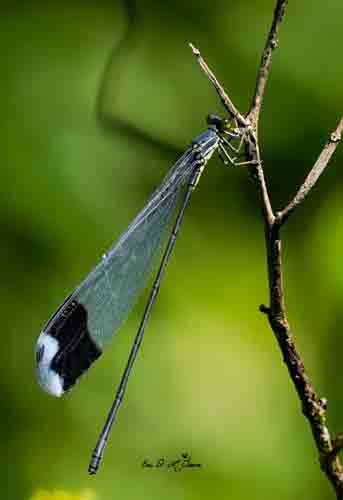
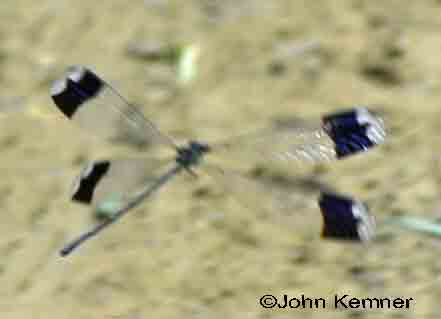
photos: males size: length, VERY LONG/SLENDER 71-115 mm male: very long dark abdomens; long wings end in a black band with 2 white areas at tips female: like male behavior: when flying, only the wingtips show, making it look like a twinkling light in the jungle; hang perch; prey on spiders in their webs; females lay their eggs in puddles formed in tree holes habitat: areas with light gaps in jungle known Jalisco flight months: tbd no Jalisco distribution map Mexican distribution map | |
|
Spreadwing Damselflies (Lestidae) 5 species documented | |
Great Spreadwing (Archilestes grandis) 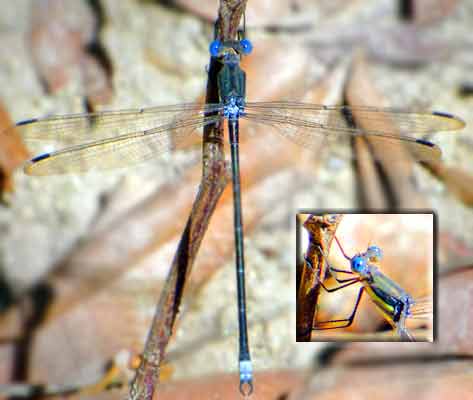
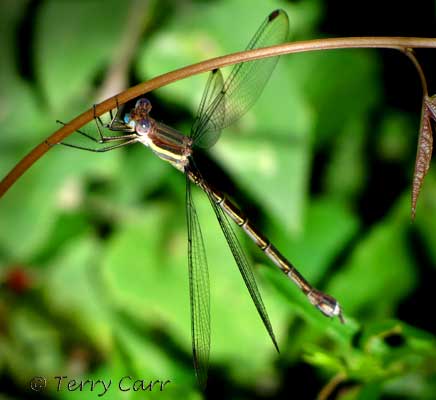
photos: males [one a insert] and female size: large, slender, length 50 - 62 mm male: wings held out straight from the body (spread); long abdomen is dark gray with greenish sheen, pruinose area near tip; one continuous pale side stripe on thorax side (yellow in mature); blue eyes & face; stigma usually dark; top appendages semicircular, lowers are divergent female: like male, but tip of tail expanded, eyes less blue behavior:wings held out straight from the body (spread); oviposit into tree branches overhanging wetlands habitat: streams with overhanging Willow trees etc. where the females place their eggs into the bark known Jalisco flight months: flies all year Jalisco distribution map Mexican distribution map | |
|
Plateau Spreadwing (Lestes alacer) 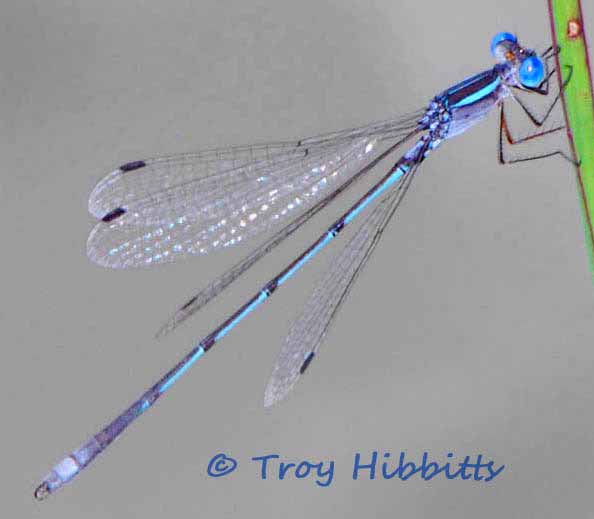
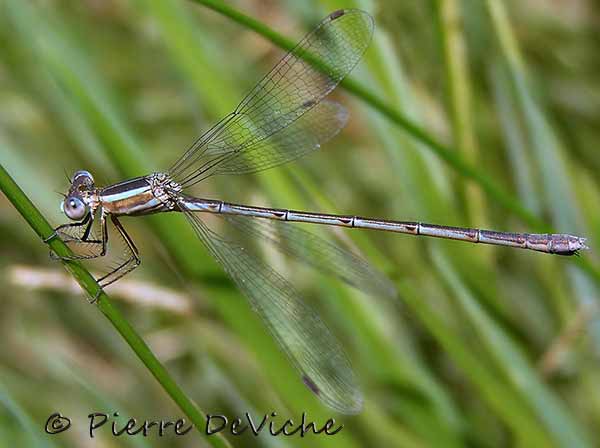
photos: male and female size: medium, slender, length 34-45 mm male: broad dark stripe top of thorax, dark side stripe variable width; pale side stripe usually a blue tint & narrowing to a point at rear; abdomen slender, esp. middle segments; reduced dark markings abdomen top; S1,2,8-10 become pruinose with age; lower appendages 75% of uppers female: similar to male or with less blue behavior: wings held out (spread); oviposit into plant stems growing over still water habitat: grass-edged ponds, slow streams at low elevations known Jalisco flight months: 1, 2, 6-12 thus far Jalisco distribution map Mexican distribution map | |
|
Blue-striped Spreadwing (Lestes tenuatus) 
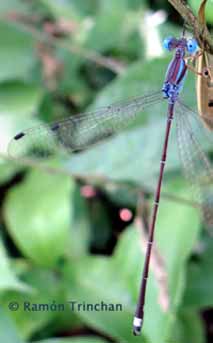
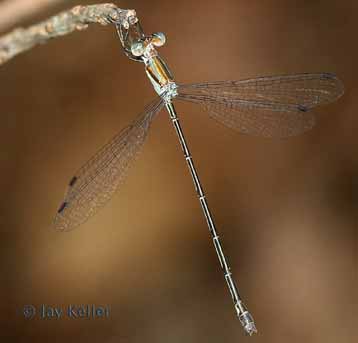
photos: males, appendages (inset) and female size: medium, slender, length ~40 mm male: large amount of blue on thorax side, second blue stripe below the upper thoracic stripe, can have a dark spot underneath the thorax; very small amount of pruinosity at tail tip, no pruinosity on S10, only on S9 female: like male or paler blue and mettalic brown behavior: Wings held out (spread); oviposit into plant stems growing over still water habitat: woodlands known Jalisco flight months: 6, 8, 12 thus far Jalisco distribution map Mexican distribution map | |
Wedge-striped Spreadwing (Lestes scalaris) prior to 2024 was Tikal Spreadwing (Lestes tikalus) 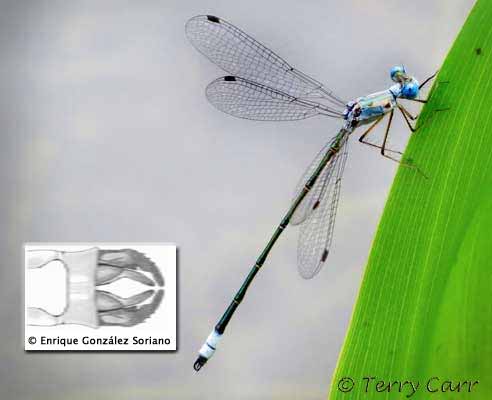
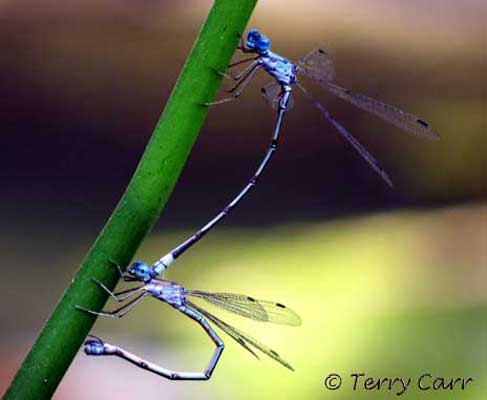
photos: male, appendages (insert) and tandem pair size: small/medium, very slender, length ~33-36 mm male: body gray with pruinose area near tip; stepped black spots on the pale blue thorax sides; short dark stigma; top appendages are semicircular and the lower ones are somewhat so, and lowers are almost as long as the uppers female: brown/tan with some green on side of thorax, ovipositor very large extending to end of abdomen similar species: L. sigma has pruinosity on the basal half of S2, which L. tikalus lacks behavior: wings held out delta-style from the body (spread); females place eggs in vegetation above where water will pool habitat:shallow ponds and marshes in forests, typically those that are drying in dry season and re-flooded in next wet season known Jalisco flight months: 2, 5, 8 thus far Jalisco distribution map Mexican distribution map | |
Chalky Spreadwing (Lestes sigma) 
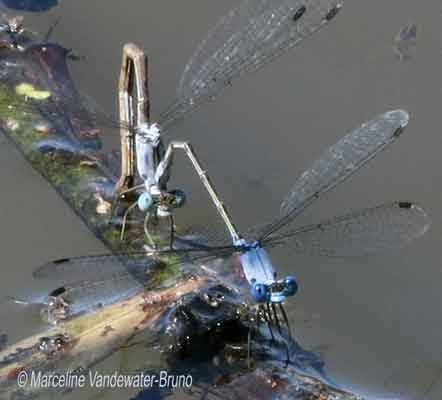
photos: mature male and ovipositing pair size: medium, slender, length 41-45 mm male: thorax becomes pruinose chalky whitish-blue/gray; long body dark with S8 & 9 pruinose; blue eyes, short dark stigma is often bi-colored; top appendages semicircular and lowers form an S-curve female: similar to male; dark abdomen with S8-10 pruinose; short ovipositor similar species: L. sigma has pruinosity on the basal half of S2, which L. tikalus lacks behavior: wings held out delta-style; females place eggs in vegetation above where water will pool habitat:shallow ponds known Jalisco flight months: 1, 2, 6, 8-12 thus far Jalisco distribution map Mexican distribution map | |
Two other Damselfly Families are documented in Jalisco. Each has only one species | |
|
Shadowdamsels (Platystictidae) 1 species documented - secretive, fly at dawn and dusk | |
|
Desert Shadowdamsel (Palaemnema domina) 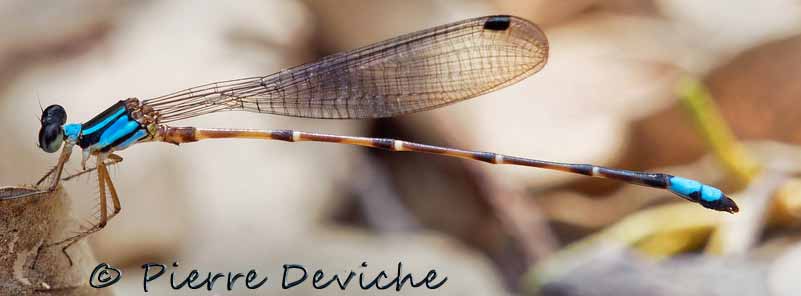 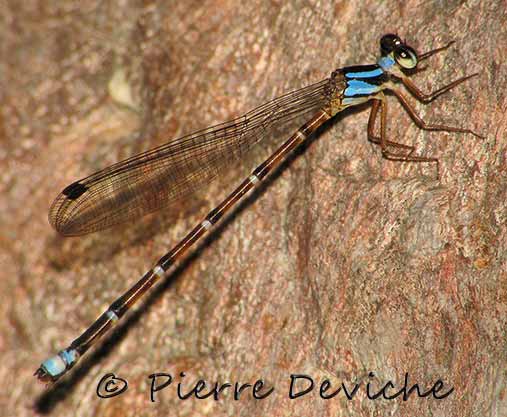
photos: male and female, RARE in Jalisco - please report any sightings size: medium, slender, length 42-45 mm male: long abdomen dark with thin pale rings, S8&9 blue; white frons; bright blue "neck" female: like male but less blue or tan where male is blue behavior: secretive; active at dawn and dusk and during light rains; dangle perch mid-day in cavities and overhanging cliffs habitat: places with high humidity in deep shade known Jalisco flight months: 7-10 thus far Jalisco distribution map Mexican distribution map | |
|
Bannerwings (Polythoridae) 1 species documented - robust bulky bodies | |
|
Blue Cora (Cora marina) 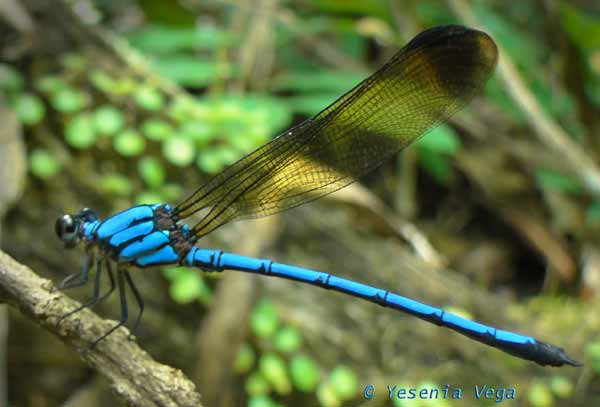
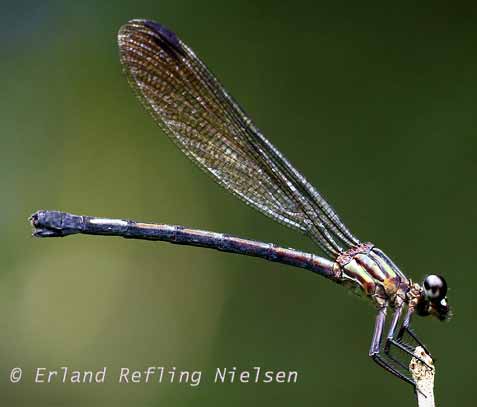
photos: male and female RARE in Jalisco please report any sightings size: medium, but bulky, length 42-45 mm male: bright blue with amber-tinted wings with dark tips; blue atop S1-8, S9&10 all dark; blue "neck"; dark eyes female: bulky and dark with light markings, wings less colored than male habitat: forest streams where they perch in shade known Jalisco flight months: 8, 9 thus far Jalisco distribution map Mexican distribution map |
Glossary:
appendages: extensions from the tip of the abdomen. Males use theirs to grasp the female during mating; unique shape for each species
pruinose/pruinosity: waxy coating a dragonfly can secrete to cover its original coloration, like the waxy coating on a plum
stigma: small thickened area on leading edge of each wing, sometimes colored
Please report sightings of new or rare species or questions to Kathy Biggs
Back to the Dragonflies (Anispotera) pages
Return to the opening page for Jalisco Odonata
Go to an opening page about Mexican Dragonflies